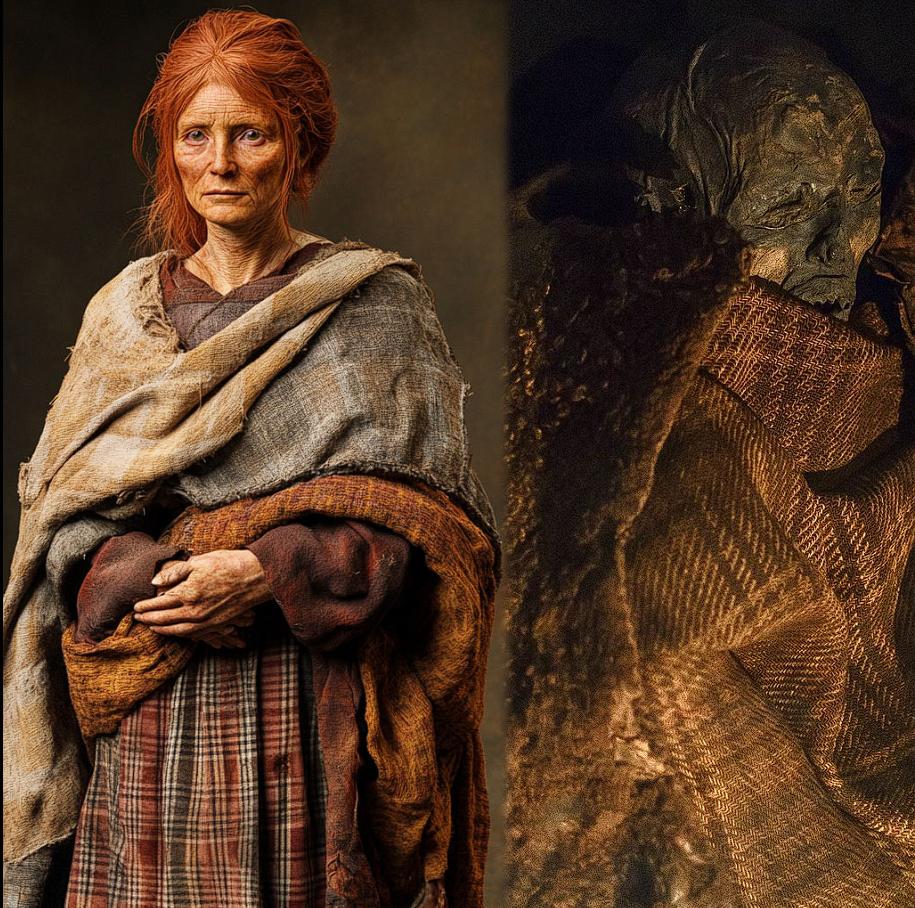“In the year 1879, from the depths of the Danish peatlands, archaeologists unearthed a figure that defied the ravages of time—a woman who had rested within the earth for over two millennia, yet whose skin, hair, and clothing remained eerily intact. Known to us as the Huldremose Woman, she stands as one of the most haunting and remarkably preserved bog bodies ever discovered, a rare and intimate window into the world of the Iron Age.”

A Life Etched in Peat: Status and Ritual in an Ancient World
- An Age of Significance: A Life Beyond the Average:
- Estimated to have lived beyond the age of 40—a testament to her longevity in that era—she represents a life marked by status and, perhaps, by the weight of ritualistic significance.
- Her very preservation, a miracle of the peatlands, speaks to a life that held a certain prominence, a life that demands our attention and invites our contemplation.
- A Violent End: The Unsettling Mystery of Her Demise:
- Her death, however, remains shrouded in an unsettling mystery. The clean severance of her right arm, possibly by a blade, has led some to speculate on the possibility of ritual sacrifice.
- In the ancient cultures of Europe, bogs were often considered sacred thresholds, liminal spaces between the mortal realm and the divine. Offerings, including human lives, were made to deities in ceremonies that ranged from reverent to brutally pragmatic.
A Tapestry of Artifacts: The Intimacy of Ancient Life
- The Garments of Time: A Narrative in Textiles:
- Her clothing, preserved with astonishing clarity, tells a vivid story of her life. She was enveloped in layers of finely woven textiles: a checked red scarf, a blue-dyed wool skirt, and two cloaks crafted from 11 lambskins.
- One of these cloaks, bearing 22 meticulously sewn patches, speaks of the garment’s value and the care with which it was maintained, a quiet testament to the hands that labored to preserve it.
- Personal Adornments: Echoes of Life and Belief:
- A bird-bone pin secured her scarf, and a bone comb, tucked within her clothing, hints at both practicality and symbolic protection. Around her neck, two amber beads, suspended from a woolen cord, suggest personal adornment or perhaps ritual significance.
- Her final meal, a humble repast of rye, seeds, and traces of animal tissue, hints at a ceremonial preparation, a final act before her journey into the unknown.
A Legacy in Peat: The Enduring Echoes of the Past
- A Silent Witness: The Preservation of a Lost World:
- To this day, the Huldremose Woman remains a silent witness to a world both alien and familiar, a bridge between our present and a distant past.
- Preserved by the very earth that claimed her, she embodies a poignant blend of everyday life, spiritual belief, and ancient mystery.
- A Call to Understanding: The Lives and Deaths of Those Who Came Before:
- Her presence continues to challenge and inspire our understanding of the lives—and deaths—of those who walked the earth before us, urging us to delve deeper into the mysteries of our shared human history.
- She is not merely an archaeological find; she is a narrative, a story etched in peat and linen, a testament to the enduring power of the past to illuminate our present.
Conclusion
“The Huldremose Woman, unearthed from the depths of the Danish peatlands, stands as a haunting and intimate chronicle of the Iron Age. Her preserved remains, a tapestry of textiles and bone, offer a glimpse into a world of ritual and belief, a time when the earth itself held the secrets of life and death. She remains, therefore, not just a historical artifact, but a silent witness, a testament to the enduring power of the past to speak to the present.”

CÁC TIN KHÁC
Mary Walton: The Forgotten Inventor Who Helped Clean Up America’s Cities
Tomb of Queen Nefertari in the Valley of the Queens, Egypt
Discover the Hypostyle Hall of the Temple of Hathor at Dendera
Venus de Losange: Unveiling the Mystery of a 20,000-Year-Old Paleolithic Icon